39 imo labels on container
How to properly label your shipment - iContainers IMO then provides a series of standardized and mandatory labels to be used for either each subclass. These labels are always diamond-shaped, and their size can usually be adapted to the package size. Each package or container should have a label on all four sides indicating the IMO class and subclass or other universal symbols standardized by IMO. IMO 8 - Containerlabels - Your Dangerous goods and safety Equipment shop 50 labels / 250 x 250 mm, vinyl removable. ADR, RID and IMDG code books and Dangerous goods E-learning
Hazard class labels - ADR and IMO - LeghornGroup The container must be labeled as required by the IMDG regulation for maritime transport. Here below some useful examples of the correct labeling. EXAMPLE 1 EXAMPLE 2 EXAMPLE 3 In case you do not find the specific product for your needs, please contact us. One of our experts will help you solve the problem.

Imo labels on container
Containers with dangerous goods: IMO labels mandatory The labels should appear on all 4 sides of the container. It is critical to ensure visibility throughout all modes of transport; both by sea, by road and by rail. Proper labeling is the shipper's obligation. It is the receiver's job to neatly remove the stickers before returning the empty clean container. More information about IMO labels ? IMO Label | NYKT Marine Co., Ltd. IMO Classes & Labels Dangerous substances fall into nine categories – explosives, high-pressure gas, flammable liquids, flammable solids, oxidizing substances, toxic substances, radioactive substances, corrosive substances, and hazardous substances. Different labels are set for each category. Q&A: What labels, marks, and placards are required on an IBC shipped ... Per the IMDG Code (i.e. the regulations of the IMO), an IBC of more than 450 L (119 gal) must be marked on two opposing sides (5.2.1.4) and must be labeled on two opposing sides (5.2.2.1.7). This differs from the domestic regulations of PHMSA which has many options but includes an option to label and mark on only one side. I hope this helps.
Imo labels on container. IMO 1.4 - Your Dangerous goods and safety Equipment shop Home / Container Labels / IMO 1.4 - Containerlabel. IMO 1.4 - Containerlabel IMO Sticker Application/Removal - APM Terminals IMO Sticker Application/Removal APM Terminals Valencia will position your IMO container in a safety zone within the terminal for the placement or removal of IMO labels for import and export containers, We guarantee compliance with local legislation. Benefits of in-terminal IMO labelling Avoid potential discharge delays for your container IMO labels removal from the containers delivered to DCT Gdansk terminal In order to organize the issues related to the IMO labels removal from the containers delivered to DCT Gdansk terminal, we inform you as below: - containers delivered by road: all empty containers (or full without hazardous cargo inside) with the presence of IMO labels - will be allowed to enter the terminal after the removal of unnecessary labels before the terminal, or after receipt the IMO & HAZARD LABELS - LeghornGroup IMO labels. LEGHORN s.r.l. specialise in the supply of hazardous goods labelling and packaging solutions to the hazardous goods transportation industry. We stock a wide range of hazard warning diamonds (Haz-Chem Labels) which are typically available for next day delivery. Popular stickers include class 3 warning diamonds, class 8 warning ...
What is an ISO Tank Container? - More Than Shipping ISO tank containers are a reliable, cost-effective (depending on the product being shipped) and definitely safe way of transporting bulk liquids. 2. ISO tanks are designed to meet specific criteria according to the substance they will be carrying. 3. Because of the above, ISO tanks are very reliable and can withstand extreme pressure and damage. 4. Safe transport of containers - International Maritime Organization IMO's International Convention for the Safety of Life at Sea ( SOLAS) includes, in its chapter VI on carriage of cargoes, requirements for stowage and securing of cargo or cargo units (such as containers). The International Convention for Safe Containers ( CSC) provides test procedures and related strength requirements for containers. IMO labels IMO labels View our updated price list Home Webshop IMO labels IMO labels Results 1 - 24 of 49 IMO 1.0 Explosive Type Select Self adhesive PP synthetic on roll (100 x 100 mm) (€ 41,00) Self adhesive vinyl, PVC (250 x 250 mm) (€ 1,25) IMO/ADR 1.4 Explosive Type Select Self adhesive PP synthetic on roll (100 x 100 mm) (€ 41,00) Containers with dangerous goods: IMO labels mandatory May 29, 2019 · If you load dangerous goods in full containers (FCL), it is mandatory to place IMO labels on the container. These labels show the hazard classes with accompanying pictograms. Dangerous substances are divided into nine categories and each category has its own set of labels: 1. Explosives 2. Gases 3. Flammable liquids 4. Flammable solids 5.
PDF DAMMERS GROUP Dammers Building Telephone: (599-9 ... - Dammers Shipagencies Recently we have received the instruction from our principals to draw your attention to the following; the IMO labels on the containers which contain(s) (ed) hazardous cargo. When you receive an import container with hazardous cargo, and the container is labelled accordingly, please remove the labels after the discharge of the container. Containers with dangerous goods: IMO labels mandatory Full Container Load. If you load dangerous goods in full containers (FCL), it is mandatory to place IMO labels on the container. These labels show the hazard classes with accompanying pictograms. Dangerous substances are divided into nine categories and each category has its own set of labels: 1. Explosives 2. IMO Sticker Application/Removal - APM Terminals APM Terminals Gijón will position your IMO container in a safety zone within the terminal for the placement or removal of IMO labels for import and export containers, We guarantee compliance with local legislation. Benefits of in-terminal IMO labelling Avoid potential discharge delays for your container Fast and agile for last minute interventions I.M.O. International Maritime Organization LABELS External controls are carried out on a container carrying hazardous goods BEFORE OPENING IT: 1. Check that the container has passed the examination for safety and that such approval has not expired. 2. Check that there all the necessary IMO labels are in place. 3. Check that there is no visible hole or crack on the container. 4.
The International Maritime Dangerous Goods (IMDG) Code The Code sets out in detail the requirements applicable to each individual substance, material or article, covering matters such as packing, container traffic and stowage, with particular reference to the segregation of incompatible substances. The Code, was initially adopted in 1965 as a recommendatory instrument.
Shipping Container Labels | A Guide | ModuGo | ModuGo The shipping container should also be labeled in accordance with DOT and/or International Maritime Organization (IMO) labeling regulations or requirements during shipping." With these tips, you can identify shipping container labels and markings like a pro. Visit our recent posts to learn more helpful information about buying shipping containers.

Shipping Labels & Handling labels to meet the needs of your shipping department; manufactured by ...
IMO labels mandatory for containers with dangerous goods May 24, 2019 · If you load dangerous goods in full containers (FCL), it is mandatory to place IMO labels on the container. These labels show the hazard classes with accompanying pictograms. Dangerous substances are divided into nine categories: 1. Explosives 2. Gases 3. Flammable liquids 4. Flammable solids 5. Oxidizing substances and organic peroxides 6.
PDF Marking of Containers Carrying Dangerous Cargoes Example 1. The container is loaded with Class 4.1 flammable solids. (Below) Correct marking on a container side Example 2. The container is loaded with Class 5.1 (Oxidizing substances), UN2880 (Below) Example 3 . Wrong positioning of placard since the placards, hazard labels, markings or
IMO Classification: Identifying Dangerous Goods - TIBA The label is white with seven vertical black lines on the top half and the number "'9", underlined, in the bottom half. These labels are always in the shape of a diamond with minimum dimensions of 100mm x 100mm. The labels may be smaller than this only if the package size requires it, as long as they are visible.
Günstige Feuchtwangen (Bavaria): September 2017 - Blogger Was ist ein MR-Diagramm (Moving Range) Ein MR-Diagramm zeichnet den Bewegungsbereich im Laufe der Zeit auf, um die Prozessvariation für einzelne Beobachtungen zu überwachen.
What Do All the Labels on Shipping Containers Mean? The letters on it are designed to withstand harsh environments that would include salty ocean spray, bleaching sun, and all kinds of abrasives, chemicals, and temperatures. The companies that own the containers can be fined if they allowed the CSC metal plate to become illegible.
IMO (Ocean) Declaration Forms - Dangerous Goods Shipper's Declaration ... Air Sea Containers, Inc. 1850 NW 94th Ave. Miami, FL 33172 305-599-9123
Dangerous Cargo, IMO Codes and Symbols - Arkas Container ... - Arkas Line As of 1st January 2004, the IMDG Code has become a mandatory requirement. For all modes of transport (sea, air, rail, road and inland waterways) the classification (grouping) of dangerous goods, by type of risk involved, has been drawn up by the UNITED NATIONS Committee of Experts on the Transport of Dangerous Goods (UN). Consists of explosives ...
Containers with dangerous goods: IMO labels mandatory If you load dangerous goods in full containers (FCL), it is mandatory to place IMO labels on the container. These labels show the hazard classes with accompanying pictograms. Dangerous substances are divided into nine categories and each category has its own set of labels: 1. Explosives 2. Gases 3. Flammable liquids 4. Flammable solids 5.
Q&A: What labels, marks, and placards are required on an IBC shipped ... Per the IMDG Code (i.e. the regulations of the IMO), an IBC of more than 450 L (119 gal) must be marked on two opposing sides (5.2.1.4) and must be labeled on two opposing sides (5.2.2.1.7). This differs from the domestic regulations of PHMSA which has many options but includes an option to label and mark on only one side. I hope this helps.
IMO Label | NYKT Marine Co., Ltd. IMO Classes & Labels Dangerous substances fall into nine categories – explosives, high-pressure gas, flammable liquids, flammable solids, oxidizing substances, toxic substances, radioactive substances, corrosive substances, and hazardous substances. Different labels are set for each category.
Containers with dangerous goods: IMO labels mandatory The labels should appear on all 4 sides of the container. It is critical to ensure visibility throughout all modes of transport; both by sea, by road and by rail. Proper labeling is the shipper's obligation. It is the receiver's job to neatly remove the stickers before returning the empty clean container. More information about IMO labels ?










Post a Comment for "39 imo labels on container"